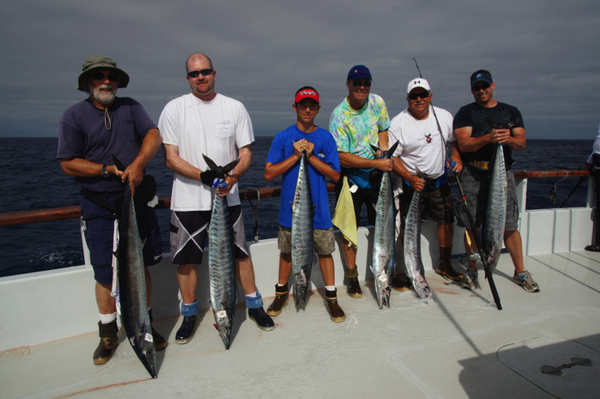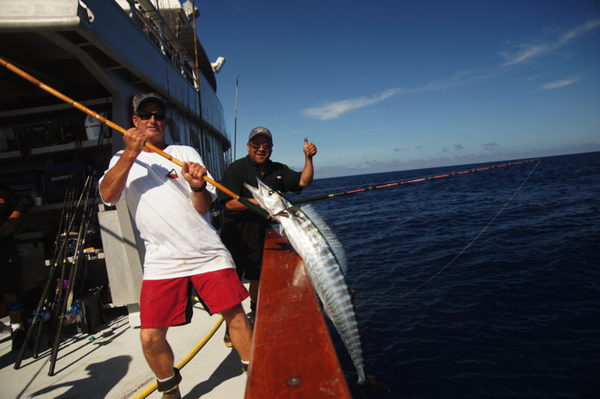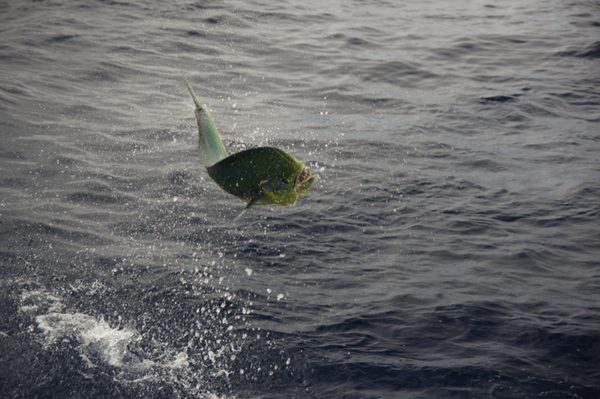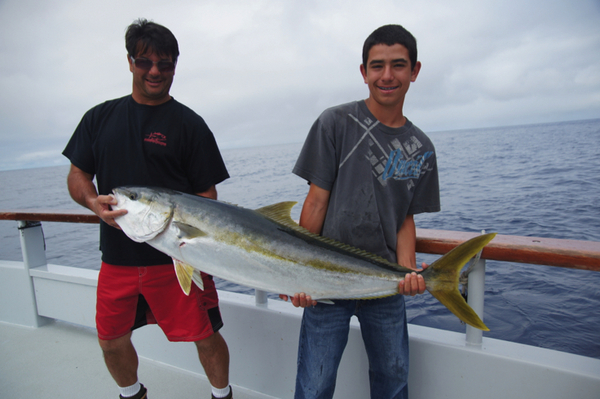Long Range Fish Report
From Sportfishing
From Sportfishing
Fish Report for 8-27-2012

Anglers aboard the Indepedndence get a primer lesson in Wahoo fishing at the Rocks
8-27-2012
Bill Roecker
https://www.independencesportfishing.com
Independence motored the last few miles to Alijos Rocks on water now warmed to 77 degrees. We saw very few birds working. That was a bit of a concern, and after we put out the trolling jigs just a couple of miles away the only fish we saw were needlefish. Skipper Mark Pisano and I were watching from the outside bridge when a big needle jumped out and "flew" like a flying fish. Neither of us had ever seen that before.
Arriving near the rocks from the north, we trolled around for nothing for 20 minutes or so. Skipper DeBuys saw little on the sonars, and we worried that there might be no fish at all around, and we'd have to make another long move. He put the boat through a pattern of zigzags, and when we came around to the south side, shouts from the stern indicated we finally had a strike.
Shooting photos from the upper afterdeck, I saw that we were in a bingo stop, with biters on all the trolling rigs and most of the jig fishermen who made casts before the boat was stopped. The bait fishermen were nipped off or hooked up before the boat settled, so we had fifteen minutes of mayhem before the wahoo backed off. Anglers cursed and shouted as they stumbled over one another trying to follow the crazed skinnies, and the crew was busy gaffing the fish that made it all the way boatside. No one had been here for a week, noted skipper Jeff, since the last time he fished the place for 30 wahoo. We hooked more than that on our first stop, but as is usually the case, two-thirds of the biters found a way to freedom, by biting the line or even the wire leaders off; or by tangling with other lines and releasing themselves with the ensuing friction. Wahoo bit on live bait and heavy jigs, some of them right at boatside, adding to angler's problems.
Some wahoo made long runs, and came up thrashing and jumping 100 yards or more from the Indy. Others ran up and down the length of the big boat, and a few slugged it out down deep. The most active of the game fish long rangers normally encounter, wahoo offer thrills and problems and high losses, since their mouths are mostly serrated razor-sharp teeth and bone. A wahoo can throw a hook with a millisecond of opportunity, as our rookies discovered.
"Keep winding, keep grinding," admonished the harried crewmen walking about with hooked-up anglers.
After the smoke cleared and the last fish was on deck and the ship's hoses cleaned up the mess, the fresh-caught skinnies were put down into a refrigerated seawater hold and skipper DeBuys got us underway on another troll.
We didn't make 200 yards before another round, another bingo bite, went off. This time we were almost ready, although many anglers were caught trying to replace terminal tackle or frayed lines. It was a replay of the first bite, with the majority of the fish coming on Raider jigs or other large irons like the Salas 6X, with single hooks. Few makers recommend treble hooks on wahoo, though I've seen some good anglers like Brandon Hayward of WON taking skinnies repeatedly on the light Salas 7X with trebles, winding in at the same slow speeds used for yellowtail.
Bait anglers who used single strand wire did just about as well as the jigcasters. Some were using a double leader of 80-pound fluorocarbon, I noticed, on their jigs. Rick Ozaki was one. Harry from Avet also accounted for numerous wahoo, showing a knack for getting his jig to the right spot for a hookup. Raiders got a lot of skinnies, in both the large and small sizes. The next morning, Ozaki told me he was down to his last five Raiders, which says something about jig losses during good wahoo bites. Some of the fish were big, but most were the usual type found at The Rocks: 20 to 40 pounds. Ben Mihm of Monrovia had never caught one before, but he took three that morning, all large, on his Raider jigs. The best wahoo was the first one he ever landed, and weighed 51.6 pounds at the dock, where he took first place on our return.
Our crew on this trip was a good one: Paul Medina, Jesus Companioni, Oscar Marroquin and Doug Brink. They were helpful, prompt to assist and polite as any you'd find elsewhere. Some anglers would have had few fish indeed if not for their assistance with tackle and casting. You could tell they were valued highly, because the tips they were left at the trip's end looked to be better than usual. The chefs in our galley were Ed LaCombe and Michel "Frenchie" BuHagiar. We ate better than well (you could say copiously, as I put on five pounds), on excellent dishes like Eggs Benedict, Prime Rib, chicken, pork chops, fresh sushi, and at one lunch, XL hamburgers with lettuce, tomatoes and all the fixin's, served at our booth tables. We had morning soups and afternoon snacks, and wonderful deserts featuring home-made ice cream with fresh-baked chocolate chip cookies and fancy sauces and a couple of kinds of cheesecake.
After those first two bingo stops we had several more, each with fewer hookups. No matter, there were 50 or 60 nice skins reposing in the wells, so skipper DeBuys anchored on the southwest side, where biting yellowtail of the larger persuasion entertained us for the rest of the bright, sunny, hot afternoon. Most yellowtail were 20 to 35 pounds, big enough to bring on a hard sweat from anglers fishing the Salas yellowtail jigs in 6X and 6X Jr. size, and from those dropping to the bottom with 12 to 16-ounce torpedo sinkers and dropper loops. Tackle for that chore was mostly 40 and 50-pound stuff, though I saw a couple of fishermen going to the 80-pound gear.
"They sure have big shoulders here," remarked one sopping angler after he'd seen his 35-pounder decked.
We tried for wahoo just before sunset without much success, so we anchored for the night on seas so calm it was almost like being tied at the dock. The next morning was a bit cooler under the overcast of the marine layer, though the water had warmed to 78 degrees. We trolled again, making several stops for another 20 or so wahoo. We had obviously thinned out that bunch yesterday, so skipper DeBuys and owner Mark Pisano ran us out to the bank, some ten miles to the southwest, to try the deep 300-foot-plus bottom there.
Some very large Patina obliged us there, and a couple of tan grouper of 25 pounds or so. There were whopper yellowtail on that bottom, and young Mark Pisano, the owner's son, used the dropper loop to get the best one of his 14 years, which caused a bit of a stir. It had spawned, or would have been a bit larger yet. He and his dad posed with the Alijos Bank mossback.
Whitefish and sheephead added to the mix of bottomfish we found there, but little to keep the whole group entertained, so DeBuys headed us back to the Rocks for one last chance at the skinnies before we had to head north. Wahoo fishing at midday was better than we any right to expect, but it was mostly on the anchor after we trolled a bit. Those big pesky yellowtail bit as though they'd missed us while we were gone, but we didn't need many more.
That's when Cindy Norred found her whopper dorado. It was nearly twice as large as any we got on the rest of the trip. A marlin was hooked, too, but it threw the hook after 15 minutes of showing its stuff, with no chance for me to shoot the release. Ted Crane got one of the two or three best yellowfin of the trip then, the only tuna we got at The Rocks. It might have won second place, but Ted doesn't enter the jackpot, for which we teased him. The Red Rooster III showed up about the time Cindy had her dorado adventure. Out of time, we pulled anchor and headed northward for the tuna grounds about a day and a half north, under overcast again that lasted all the way home.
Things had changed during the week we were gone. The heat wave was broken, the air and water up toward San Diego were cooler. The next morning, as we searched for the tuna that bit like crazy the day before, numerous land birds found the boat to be a spot to sit down. They may have been early migrants, lost under the cloud cover. Two white winged doves, a mourning dove, a pair of song sparrows and a gorgeous black, white and orange finch of some sort sought refuge with the Indy. We collected almost as many birds as tuna. We found a couple of dozen, but they were small yellowfin, pretty but not much desired. Most were trolled up on the Zucker's, but a couple of stops produced a smattering of baitfish. Much of the long range fleet seemed to be nearby as we headed north, and 30 miles uphill we found the dayfleet. Some of them, like Markus Medak aboard his New Lo-An, had found good biters and made limit catches, I learned when we arrived at Pt. Loma Sportfishing. We were good, as they say. We had all the fish we needed: limits of yellowtail, 90-some wahoo, the bottomfish and a decent catch of bluefin and yellowfin tuna. I believe the wahoo catch we made at The Rocks was the best of the new season. At the weighing, Ben Mihm's wahoo of 51.6 pounds took first place, Doug Townsend of Sierra Madre won second place for his 42.5-pound yellowfin, and Cindy Norred won third place for her remarkable 41.2-pound dorado.
Thanks to all my sponsors, including AA's/Optimum swimbaits, whom I forgot to mention in yesterday's first installment, to chartermaster Rick Ozaki of West Coast Marketing and Harry Alajajyan of Avet for their contributions. Kudos to skipper Jeff DeBuys for working his behind off getting us on the fish, and to Mark Pisano for the invitation to shoot video and photos on his very special boat. And for the crew? Good on you, boys, good on you.
Arriving near the rocks from the north, we trolled around for nothing for 20 minutes or so. Skipper DeBuys saw little on the sonars, and we worried that there might be no fish at all around, and we'd have to make another long move. He put the boat through a pattern of zigzags, and when we came around to the south side, shouts from the stern indicated we finally had a strike.
Shooting photos from the upper afterdeck, I saw that we were in a bingo stop, with biters on all the trolling rigs and most of the jig fishermen who made casts before the boat was stopped. The bait fishermen were nipped off or hooked up before the boat settled, so we had fifteen minutes of mayhem before the wahoo backed off. Anglers cursed and shouted as they stumbled over one another trying to follow the crazed skinnies, and the crew was busy gaffing the fish that made it all the way boatside. No one had been here for a week, noted skipper Jeff, since the last time he fished the place for 30 wahoo. We hooked more than that on our first stop, but as is usually the case, two-thirds of the biters found a way to freedom, by biting the line or even the wire leaders off; or by tangling with other lines and releasing themselves with the ensuing friction. Wahoo bit on live bait and heavy jigs, some of them right at boatside, adding to angler's problems.
Some wahoo made long runs, and came up thrashing and jumping 100 yards or more from the Indy. Others ran up and down the length of the big boat, and a few slugged it out down deep. The most active of the game fish long rangers normally encounter, wahoo offer thrills and problems and high losses, since their mouths are mostly serrated razor-sharp teeth and bone. A wahoo can throw a hook with a millisecond of opportunity, as our rookies discovered.
"Keep winding, keep grinding," admonished the harried crewmen walking about with hooked-up anglers.
After the smoke cleared and the last fish was on deck and the ship's hoses cleaned up the mess, the fresh-caught skinnies were put down into a refrigerated seawater hold and skipper DeBuys got us underway on another troll.
We didn't make 200 yards before another round, another bingo bite, went off. This time we were almost ready, although many anglers were caught trying to replace terminal tackle or frayed lines. It was a replay of the first bite, with the majority of the fish coming on Raider jigs or other large irons like the Salas 6X, with single hooks. Few makers recommend treble hooks on wahoo, though I've seen some good anglers like Brandon Hayward of WON taking skinnies repeatedly on the light Salas 7X with trebles, winding in at the same slow speeds used for yellowtail.
Bait anglers who used single strand wire did just about as well as the jigcasters. Some were using a double leader of 80-pound fluorocarbon, I noticed, on their jigs. Rick Ozaki was one. Harry from Avet also accounted for numerous wahoo, showing a knack for getting his jig to the right spot for a hookup. Raiders got a lot of skinnies, in both the large and small sizes. The next morning, Ozaki told me he was down to his last five Raiders, which says something about jig losses during good wahoo bites. Some of the fish were big, but most were the usual type found at The Rocks: 20 to 40 pounds. Ben Mihm of Monrovia had never caught one before, but he took three that morning, all large, on his Raider jigs. The best wahoo was the first one he ever landed, and weighed 51.6 pounds at the dock, where he took first place on our return.
Our crew on this trip was a good one: Paul Medina, Jesus Companioni, Oscar Marroquin and Doug Brink. They were helpful, prompt to assist and polite as any you'd find elsewhere. Some anglers would have had few fish indeed if not for their assistance with tackle and casting. You could tell they were valued highly, because the tips they were left at the trip's end looked to be better than usual. The chefs in our galley were Ed LaCombe and Michel "Frenchie" BuHagiar. We ate better than well (you could say copiously, as I put on five pounds), on excellent dishes like Eggs Benedict, Prime Rib, chicken, pork chops, fresh sushi, and at one lunch, XL hamburgers with lettuce, tomatoes and all the fixin's, served at our booth tables. We had morning soups and afternoon snacks, and wonderful deserts featuring home-made ice cream with fresh-baked chocolate chip cookies and fancy sauces and a couple of kinds of cheesecake.
After those first two bingo stops we had several more, each with fewer hookups. No matter, there were 50 or 60 nice skins reposing in the wells, so skipper DeBuys anchored on the southwest side, where biting yellowtail of the larger persuasion entertained us for the rest of the bright, sunny, hot afternoon. Most yellowtail were 20 to 35 pounds, big enough to bring on a hard sweat from anglers fishing the Salas yellowtail jigs in 6X and 6X Jr. size, and from those dropping to the bottom with 12 to 16-ounce torpedo sinkers and dropper loops. Tackle for that chore was mostly 40 and 50-pound stuff, though I saw a couple of fishermen going to the 80-pound gear.
"They sure have big shoulders here," remarked one sopping angler after he'd seen his 35-pounder decked.
We tried for wahoo just before sunset without much success, so we anchored for the night on seas so calm it was almost like being tied at the dock. The next morning was a bit cooler under the overcast of the marine layer, though the water had warmed to 78 degrees. We trolled again, making several stops for another 20 or so wahoo. We had obviously thinned out that bunch yesterday, so skipper DeBuys and owner Mark Pisano ran us out to the bank, some ten miles to the southwest, to try the deep 300-foot-plus bottom there.
Some very large Patina obliged us there, and a couple of tan grouper of 25 pounds or so. There were whopper yellowtail on that bottom, and young Mark Pisano, the owner's son, used the dropper loop to get the best one of his 14 years, which caused a bit of a stir. It had spawned, or would have been a bit larger yet. He and his dad posed with the Alijos Bank mossback.
Whitefish and sheephead added to the mix of bottomfish we found there, but little to keep the whole group entertained, so DeBuys headed us back to the Rocks for one last chance at the skinnies before we had to head north. Wahoo fishing at midday was better than we any right to expect, but it was mostly on the anchor after we trolled a bit. Those big pesky yellowtail bit as though they'd missed us while we were gone, but we didn't need many more.
That's when Cindy Norred found her whopper dorado. It was nearly twice as large as any we got on the rest of the trip. A marlin was hooked, too, but it threw the hook after 15 minutes of showing its stuff, with no chance for me to shoot the release. Ted Crane got one of the two or three best yellowfin of the trip then, the only tuna we got at The Rocks. It might have won second place, but Ted doesn't enter the jackpot, for which we teased him. The Red Rooster III showed up about the time Cindy had her dorado adventure. Out of time, we pulled anchor and headed northward for the tuna grounds about a day and a half north, under overcast again that lasted all the way home.
Things had changed during the week we were gone. The heat wave was broken, the air and water up toward San Diego were cooler. The next morning, as we searched for the tuna that bit like crazy the day before, numerous land birds found the boat to be a spot to sit down. They may have been early migrants, lost under the cloud cover. Two white winged doves, a mourning dove, a pair of song sparrows and a gorgeous black, white and orange finch of some sort sought refuge with the Indy. We collected almost as many birds as tuna. We found a couple of dozen, but they were small yellowfin, pretty but not much desired. Most were trolled up on the Zucker's, but a couple of stops produced a smattering of baitfish. Much of the long range fleet seemed to be nearby as we headed north, and 30 miles uphill we found the dayfleet. Some of them, like Markus Medak aboard his New Lo-An, had found good biters and made limit catches, I learned when we arrived at Pt. Loma Sportfishing. We were good, as they say. We had all the fish we needed: limits of yellowtail, 90-some wahoo, the bottomfish and a decent catch of bluefin and yellowfin tuna. I believe the wahoo catch we made at The Rocks was the best of the new season. At the weighing, Ben Mihm's wahoo of 51.6 pounds took first place, Doug Townsend of Sierra Madre won second place for his 42.5-pound yellowfin, and Cindy Norred won third place for her remarkable 41.2-pound dorado.
Thanks to all my sponsors, including AA's/Optimum swimbaits, whom I forgot to mention in yesterday's first installment, to chartermaster Rick Ozaki of West Coast Marketing and Harry Alajajyan of Avet for their contributions. Kudos to skipper Jeff DeBuys for working his behind off getting us on the fish, and to Mark Pisano for the invitation to shoot video and photos on his very special boat. And for the crew? Good on you, boys, good on you.
Photos
< Previous Report Next Report >
More Reports

8-26-2012
When the whopper bull dorado started jumping it was a long way off from the stern. It never stopped, even...... Read More
Fishing Videos Reports
for Tuesday, August 14th, 2012
• Intrepid Angler lands an albacore, bluefin tuna, yellowfin tuna, dorado, & a yellowtail....Wow!
• The Searcher finishes their trip with a good paddy and very good Yellowfin & Bluefin fishing

LongRangeSportfishing.net © 2025. All Rights Reserved.
Website Hosting and Design provided by TECK.net
Website Hosting and Design provided by TECK.net



